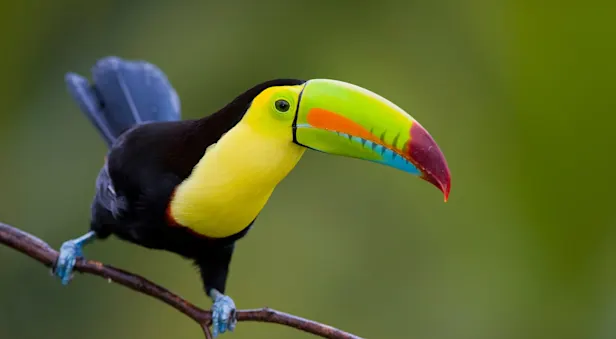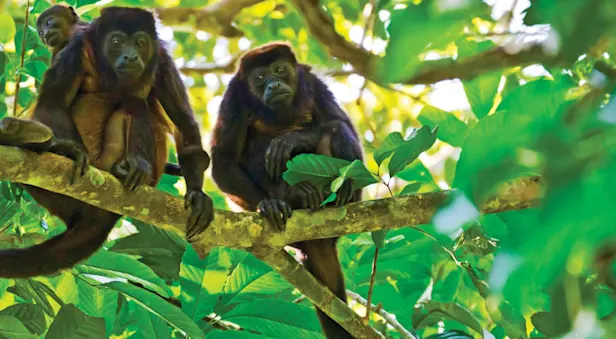Itinerary
Arrive in the capital of San Jose and transfer to our relaxing resort hotel high in the foothills north of the city, where our Costa Rica ecotour begins with a welcome dinner. If you reach the hotel early, enjoy a walk around the lavish gardens, home to abundant birdlife.
This morning we head to Paos Volcano, one of the largest active volcanoes in the world. When visibility allows, marvel at the massive aquamarine crater lakes—the larger of the two is more than a mile wide and 900 feet deep—and the active geysers that send boiling water up to 600 feet in the air. On days with dense cloud cover, we turn our focus to the surrounding dwarf forest whose stunted trees and vegetation illustrate the impact of acid rain produced by the volcano’s emissions.
In the afternoon, explore one of Costa Rica’s famous agricultural pursuits: growing some of the world’s finest coffee. On a tour of the Doka coffee plantation, learn about best practices in coffee production, from seed germination to cultivating the plants and processing the beans. Our guide tells us about the local history and geography of coffee as we start in the seedbed, then progress to the historic processing plant that’s listed on the Architectural Heritage for Humanity list. Continuing to the roasting room and cafe, we can sample the different blends made on the Doka Estate. Back at Xandari Lodge, there’s time to walk in the impressive gardens and forest trail network with views of the Central Valley far below.
Transfer to the local airport this morning to board chartered planes for our direct flight to Golfito on Costa Rica’s remote southern Pacific coast. Upon landing, we embark on a private cruise around Golfo Dulce. Look for bottlenose and spotted dolphins, and rarer sightings of hammerhead sharks, whale sharks and rays. Few visitors to Costa Rica make it to this intensely biodiverse region along the Osa Peninsula, surrounded by the country's largest tracts of untouched primary rainforest. National Geographic identified Golfo Dulce—a rare tropical fjord biome—as one of the world's most pristine seas.
After lunch, head to Tiskita Jungle Lodge, an 800-acre private rainforest reserve, and the only lodging in this undeveloped area just a few miles from the Panama border. We stay in hand-built cabins, crafted from fallen hardwood trees, which survey the sea from a high ridge. Wildlife abounds: Look for squirrel monkeys, howler monkeys and white-faced capuchins swinging through the trees, sloths clinging to high branches, and agouti in the underbrush. More than 275 bird species thrive in this lush habitat, and we search for some of them on a guided walk around the grounds. A coveted sighting is the scarlet macaw, successfully reintroduced by Tiskita's owners and now flourishing on the reserve.
Spend a full day and evening exploring more of this impressive private biological reserve, which has been a national leader in restoring an altered landscape to its wild native state. An extended rainforest hike reveals more wild creatures, while a night walk offers a chance to look for red-eyed tree frogs, tiny endangered granular poison dart frogs and other intriguing amphibians that create a noisy chorus after dark. Meals at our secluded ecolodge are a highlight and are prepared with fresh ingredients from the property, incorporating some of the 125 types of organic tropical fruit grown on the estate. After lunch, we tour the orchard, examining a wide array of fruit trees, and, when certain fruits are in season, we may get to taste some exotic varieties. Our afternoon walk also offers an excellent chance to see birds and monkeys attracted to the orchards and their abundant fruit.
Explore more of the reserve this morning, then walk to the beachside village of Punta Banco to visit a community sea turtle hatchery. During a talk by a local biologist running this grassroots conservation program, learn firsthand the critical value of controlled hatcheries that are helping to increase endangered sea turtle populations worldwide. For groups visiting during turtle-hatching season from November–January, we may have the opportunity for a pre-dawn visit to the beach to see baby olive ridley turtles emerging from their nests and being released to the sea.
Transfer to Golfito by road to meet our private chartered plane, which takes us north to San Isidro. Here, we board vans for one of the most spectacular drives in Costa Rica, ascending narrow, winding roads into the Talamanca Mountains. Our route crosses Cerro de la Muerte, the highest point along the Costa Rican section of the Pan-American Highway at just under 11,000 feet. The views are thrilling, when the frequent mists clear enough to reveal waterfalls on steep slopes and green valleys far below. Along the way, we stop for lunch at the home of a local family, savoring traditional home-cooked fare and learning about rural life in Costa Rica. Our hosts live on a small farm where they grow mushrooms on oak logs and make delectable blackberry wine, both of which feature in our meal.
Our destination is the cloud forest along the Savegre River, which rushes down a narrow, high mountain valley at 7,200 feet. Our lush surroundings are replete with flowering tropical plants and myriad colorful birds—the resplendent quetzal is the biggest prize among the more than 600 different bird species found here. Once we’re settled in to our lodge along the river, we’ll take a guided walk through the gardens on the grounds.
This high-altitude ecosystem will thrill bird lovers, as it is home to a multitude of vibrant species and many endemics. We set out this morning for Los Quetzales National Park, encompassing more than 12,000 acres of pristine cloud forest and 14 different ecosystems. The park protects wild sections of the Savegre River, which originates high upon the Cerro de la Muerte. Our goal is to spot the resplendent quetzal, a revered and endangered creature of striking beauty. Listen for their deep, melodious calls as we quietly track these elusive birds. Photographers come from all over the world in hopes of capturing a shot of the quetzal's splendid plumage, with its electric green head, scarlet breast and long, iridescent turquoise tail. Our nature walk reveals a wide array of birds, and we may also spy the emerald toucanet, golden-browed chlorophonia and spangle-cheeked tanager, among many others.
A highlight is lunch at Paraiso Quetzal—"Quetzal Paradise"—an ecolodge perched on a steep mountainside. From the outdoor deck we're sure to see dozens of hummingbirds buzzing around several feeders, offering superb close-up photo opportunities. Later this afternoon, we'll visit Batsu Gardens, where every detail has been intentionally designed to enhance outstanding bird photography opportunities in a lush natural space. This evening, our nature adventure comes to a close over a farewell dinner at a special local restaurant.
After breakfast, a group transfer is provided to the San Jose airport to connect with departing flights. Please schedule flight departures no earlier than 1:30 pm today.


































